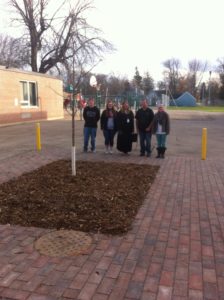Written by YES! Coordinator Ali Dahmes
“It is so great to be a part of something that positively affects the community in which we live,” recalls Gabra Lokken, Atwater-Cosmos-Grove City (ACGC) YES! coach while observing their tree trench. Although it is mostly completed, there were many substantial steps along the way. The Middle Fork Crow River Watershed District (MFCRWD) applied and received the Minnesota Clean Water Fund Community Partners grant that is provided by Minnesota Board of Soil & Water Resources (BWSR). After receiving the grant, MFCRWD decided YES! was a fitting organization to install an on-the ground project (such as a tree trench) that reduces runoff. MFCRWD turned to the YES! team at ACGC to discover if there was a need in their community since the school district fell within the watershed district. The YES! team talked to their head maintenance staff who had a suggestion. The ACGC elementary school had an addition where rain water was pooling by an outdoor walk-in freezer and a hallway exit door. As the pooling increased during heavy rainfall, water eventually made its way into the hallway. Although unfortunate for the school, it provided ACGC with a wonderful YES! project to divert that rain water!
An engineer traveled to ACGC and found that the area in question was an impermeable surface and that a stormwater drainage pipe ran close, so it was a suitable spot to implement a stormwater best management practice (BMP). BMPs effectively prevent or reduce the pollution of groundwater or surfaces. Since there was a stormwater drainage pipe running through the area, it was the perfect location to install a tree trench since it would not have to work solely on its own. In other words, it provided a failsafe in case the system is ever overloaded.
On the surface, the tree trench looks like plants within a square bricked in area, but there is much more happening below. Initially, runoff is stored in the spaces between the stones. As water flows through the system, the soil initially filters it. Then, water is taken up by plants and nutrients are scrubbed off. This allows for plants to use water over time and filter water before going back into bodies of water below and above ground. If the capacity of the system is exceeded during a large rainfall, the water can bypass the system completely and head directly into the drainage pipe.
The initial project was completed late October, but AGCG will still be planting shrubbery in the spring near the lone tree. The initial grant funded 75% of the project while 25% was funded by the school. However, Kandiyohi County Water Planning Task Force (KCWPTF) has a Cost Share Program that will be sharing the cost with the school now that the project is complete. ACGC plans to have a dedication/opening event this spring after the rest of the shrubbery is planted.
